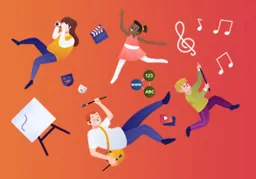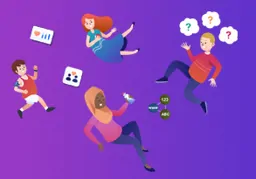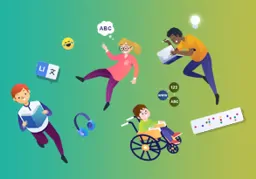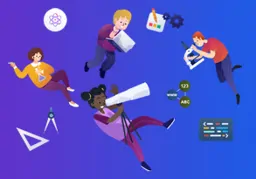AREA OF LEARNING AND EXPERIENCEMathematics and Numeracy
Guidance to help schools and settings develop their own curriculum, enabling learners to develop towards the four purposes.
5. Designing your curriculum
This provides specific guidance to be used when incorporating learning in mathematics and numeracy in your curriculum. It should be read together with the overarching Designing your Curriculum section which is relevant to learning and teaching across all areas of learning and experience.
Cross-curricular skills and integral skills
A curriculum must embed the mandatory cross-curricular skills and the integral skills which underpin the four purposes of the curriculum. Below are some key principles which settings and schools should consider when designing learning and teaching in the Mathematics and Numeracy Area of Learning and Experience (Area).
Cross-curricular skills
Literacy
Practitioners should develop engaging and accessible experiences where learners are given regular opportunities to describe, explain and justify their understanding of various mathematical concepts, using appropriate mathematical vocabulary. Literacy skills can also be developed in order to describe mathematical processes, such as reasoning, understanding a range of calculation strategies, describing visualisation of shapes, studying and interpreting information in statistics and comparing alternative methods before arriving at a solution to a mathematical problem. These literacy skills can be used as they encounter practical, real-life problems.
Numeracy
This Area, by definition, has numeracy at its heart. The five mathematical proficiencies – Conceptual understanding, Communication using symbols, Fluency, Logical reasoning and Strategic competence – can be applied and connected by using a range of real-life contexts to introduce and explore mathematical concepts, as well as to consolidate them. For example, percentages can be applied to annual percentage rates (APRs) to demonstrate their use in financial literacy.
Digital competence
Digital approaches enhance learners’ mathematical and numeracy skills across a range of situations that will naturally occur within the area of learning and experience. This is more than simply the interaction with technology. For instance, the development of learners’ digital skills could be done by collaborating to solve a problem and developing algorithms to support the understanding of patterns. Another instance would be creating a graph by using a spreadsheet to enhance digital understanding and also strengthen learners’ mathematical and numeracy skills. As learners develop and progress, they will increasingly use more complex digital skills, processes, techniques and systems to create solutions to address specific problems, opportunities or needs. Aspects of collection, representation and analysis, for example, will become more sophisticated as learners progress.
Integral skills
Creativity and innovation
Mathematical working requires and develops creativity and curiosity which also transfer to other aspects of life. Frequently in mathematical problem-solving the learner does not immediately know how to approach the problem; it takes creativity and courage to explore different approaches before deciding how to proceed. Planning and modelling tasks within mathematics develops learners’ ability to turn ideas into action.
Critical thinking and problem-solving
The development of logical and critical thinking underpins learning in mathematics. Mathematics teaches us problem-solving skills which transfer to all areas of the curriculum, to life in general and to the world of work. Mathematics involves solving problems and begins by analysing the requirements, before then asking questions and evaluating information. In the development of solutions, learners identify potential approaches and develop arguments, justifying their decisions.
Personal effectiveness
Studying mathematics develops personal effectiveness. When studying mathematics everyone encounters challenges at some point, and overcoming these challenges requires and develops resourcefulness and resilience. Communicating about mathematical thinking and solving problems is a core aspect of mathematics. Mathematical communication is precise and logical and will be useful in life generally.
Planning and organising
Mathematical thinking requires learners to be organised and, as they progress through school, their organisational skills will develop, particularly as they plan and implement the sequential data-handling cycle. In their mathematical problem-solving, learners should be encouraged to predict and estimate solutions and then to check their answers, reflect on their results and evaluate their approaches. Increasing confidence in decision-making for mathematical problem-solving supports learners to be more aspirational in setting goals and challenges for themselves including planning how to achieve these.
Specific considerations for this Area
The different areas of mathematics are highly interconnected and dependent on one another and concepts are built up over time, drawing on prior knowledge and learning, often from more than one area of mathematics. What is important when planning to teach any specific topic is to be aware of the prior knowledge the learners need in order to access and understand the new topic.
Algebra, geometry and statistics cannot be understood without a prior understanding of number and consistent reference to numbers, calculations and the number system. As learners progress, they learn to see numerical expressions as relational rather than computational, e.g. a computation such as 2 + 8 = 10, and that this is the basis for deriving other facts, e.g. 8 + 2 = 10, 8 = 10 – 2, and so on. This lays the foundations for using algebraic symbolisation successfully.
Making connections between arithmetic and algebra helps to develop tools and skills for abstract reasoning from an early age. Measure is an aspect of geometrical thinking which is closely connected to number, and much of the development of understanding of number can emerge through increasingly sophisticated measuring. Geometric thinking involves proportional reasoning, which connects with development in number work; it also involves transforming shapes, which relates to the use of functions and mapping in algebra. Probability is expressed through number in various ways, using percentages, fractions and decimals, and an understanding of the different representations; the connections between them are necessary for effective expression of probability. Statistics involves manipulation, representation and interpretation of data, which in turn require numerical and geometric thinking.
The aspiration is to deliver this Area so that there is a shift in culture towards learners fostering a positive and resilient attitude towards it.
Considerations for curriculum development
- Learners should be given opportunities to explore mathematically rich environments both indoors and outdoors. The environment will be developmentally appropriate and facilitate first-hand experiences with mathematical concepts and a range of resources.
- The structure and sequence of mathematics and numeracy topics should be informed by the hierarchical and connected nature of mathematical concepts, in order to ensure foundations are built upon and experiences are connected.
- Learners need to become increasingly fluent in their use of number, through a broad range of experiences, in order to describe, interpret and communicate size, scale and comparisons, both within and beyond mathematics. They should also become increasingly fluent in their calculations, both with and without the use of calculators.
- By introducing a reasoning and problem-solving approach to all mathematics and numeracy experiences, the development of the four purposes and positive dispositions will be supported.
- By using real-life examples to introduce, explore and consolidate mathematical concepts, learners of all ages make connections between the concrete, the pictorial and the abstract. Through a broad range of experiences, learners appreciate the power of mathematics to express relationships concisely, in forms that are universally understood.
- Learners should engage in meaningful and substantial tasks such as: modelling real-life numerical problems, financial calculations such as creating and evaluating budgets for events and analysing risks, developing mathematical sequences through patterns in nature and using the sequential data-handling cycle to pose and investigate their own research questions.
- Practitioners should consider the appropriate use of a range of digital technologies, manipulatives, everyday objects, and concrete and abstract representations of mathematical objects to help learners to engage with mathematical concepts from more than one perspective.
- It is important that learners are able to interpret answers and check that they make sense in context, including by estimation, and are able to use appropriate methods to answer questions by collecting, analysing and summarising data and interpreting results. They are able to evaluate their methods and suggest different or better ways to approach investigations in the future.
- Deep understanding in mathematics and numeracy should develop through planning for all five of the mathematical proficiencies, and the connection and application of these in a range of contexts.
- The proficiencies are interconnected and interdependent; they cannot be seen as hierarchical and they can be developed alongside each other. Learners will develop their mathematical proficiencies at different times and may be developing several at the same time. For example, as a child becomes more fluent in adding two-digit numbers, they will be developing their conceptual understanding of place value.
- It is not expected that all five proficiencies will be developed in a single session, but all five need to be developed during a particular mathematical concept. There are certain processes and applications, for example the sequential data-handling cycle, which should be introduced from the outset, as they are essential to conceptual understanding.
Using the proficiencies, a contextual example: Learning about fractions – the case of ½
Conceptual understanding
Understanding that a half is a result of dividing something into two equal parts. This could be through connecting concrete and/or real-life experiences of partitioning objects and numbers into equal parts with images (e.g. pictures and images on the number line) and the abstract representation of a ½ using the symbolic notation. A learner who understands what a half is might be able to give real-life or visual examples, and would also be able to explain why something might not be a half (e.g. a pizza cut into two parts which are not equal).
Communicating using symbols
Understanding the convention of how a half is written and what the symbols mean. This could also involve linking division and fractions (i.e. ½ = 1 ÷ 2) and using terms such as numerator and denominator.
Strategic competence
Being able to recognise real-life situations which involve a half and being able to represent these mathematically; being able to model situations involving halving mathematically; using pictures/images and language and symbols to illustrate a half.
Fluency
Being able to count in steps of a half and being able to begin to recall halves of numbers.
Logical reasoning
Being able to understand the relationship between a half and a whole; being able to justify why is also a half. Being able to reason that ½ + ½ = 1, ½ x 2 = 1 and 1 ÷ 2 = ½. Being able to justify why there may be many ways of splitting a shape in half.
Through connecting these proficiencies within a learner’s experience of ½, learners should develop a deep understanding of a half as an example of a fraction. The way in which these foci are introduced could vary, but ultimately, having opportunities to explore and connect these proficiencies should ensure learner progression within this concept.
Considerations for pedagogy
- There is no research that says one way of teaching mathematics is better than any other. Nevertheless pedagogy should ensure the overall development of these proficiencies and also be relevant for the mathematics being taught.
- Mathematics teaching needs to be conceptually connected and coherent. This requires mastery and memory of earlier concepts; comprehensible starting points; consistent use of language, symbols, images and other representations; illuminating choice of examples; relevant use of digital tools. These should be combined into lesson sequences which might include problem-solving, exploration, direct instruction, application, exercises and extended tasks as appropriate for the specific mathematics being taught and the overall development of the five proficiencies. At any point in a sequence the mathematical focus might be a new concept, an extension of an earlier concept, a relationship, a technique, a fact, a theorem, a mathematical strategy or a way of thinking.
- Guiding questions and information about choice and sequencing of pedagogical approaches to manage this diversity will be included in the resource on pedagogy.
Illustrating breadth
The following are provided as examples of how you could explore different topical learning in this Area. These are illustrations only.
Numeracy and knowledge of real-world contexts could include understanding exchange rates, mortgage calculations and taxation, including the developing system of Welsh taxes. Through algebraic thinking and knowledge, learners could develop capabilities that can be applied to topics including personal finance and energy production in Wales and elsewhere. Geometry could draw examples from, and help develop a knowledge of, urban development as it differs across Wales, medical technology and computer imaging. From a strong foundation of problem solving, logical reasoning and understanding data, Mathematics and Numeracy is critical for informed citizens who are ready to play a full part in life and work.
Key links with other Areas
When designing your curriculum, you should consider how learning links across Areas in order to achieve a holistic approach to learning. Mathematics and numeracy can be used across all other Areas to enhance, stimulate and support learning. Equally, mathematics and numeracy can be developed through other Areas. Some of the key links to learning in this Area are detailed below.
Expressive Arts
The use of numeracy and concepts from this Area are embedded in the Expressive Arts Area of Learning and Experience supporting all disciplines. Consideration should be given to counting, sequencing and time and the exploration of how space, patterns, symmetry, shape and position can be used across the arts. Ratios, scale, proportions and fractions can also be explored in the Expressive Arts, for example in music. The use of songs and rhymes can assist with the embedding of numeracy during the early progression steps.
Health and Well-being
One of the most important links is with the Health and Well-being Area of Learning and Experience and an example would be around financial literacy and risk. Financial literacy is provided for in the statement of what matters dealing with the number system. This is complemented in health and well-being where learning could explore financial literacy through risk and personal debt, and its consequences. Because of such close links, it is strongly recommended that both elements are taught in parallel.
The Health and Well-being Area of Learning and Experience also provides learners with the knowledge and understanding of the process of decision-making, including the implications of decisions and consideration of risk. Numeracy provides an important context in which to explore and support positive decision-making, particularly in respect of financial decisions.
Furthermore, the Health and Well-being Area of Learning and Experience provides opportunity to explore the role of numeracy in purchasing and preparing food to support nutrition and its role in measuring distance, weight and time.
Humanities
The Humanities Area of Learning and Experience provides authentic contexts for the application of mathematics and numeracy skills. Enquiries in the humanities will use a range of qualitative and quantitative data. Humanities enquiries will often include the collection of primary data using sampling methods, and the representation and analysis of data and statistics in a range of forms. Learners are provided with opportunities to sort and classify data, and identify patterns, trends and anomalies. Supporting entrepreneurship, ratio and scale; finance; rounding; ordering will also be relevant.
Languages, Literacy and Communication
Songs and rhymes can be used to teach early numeracy in all languages. Finding and applying patterns for problem solving is a skill required for progress in these two Areas.
Science and Technology
From the use of data and statistics in inquiry and evidence, geometry and measurement in design and development, through to data handling in technology learning in science and technology is often underpinned by progression in mathematical understanding, as expressed through the five mathematical proficiencies. Curriculum links between these two Areas are, therefore, multiple and often quite detailed. Schools may wish to consider curriculum sequencing in particular when designing and planning their curriculum to ensure opportunities in science and technology to contextualise mathematical conceptual learning are fully optimised.
Cross-cutting themes
Local, national and international contexts in this Area
Mathematics is a universal language. To make sense of this language and to understand mathematical concepts, learners need examples rooted in everyday life. This is especially important for young learners who are often unable to think abstractly. Learning within local, national and international contexts will enable learners to understand the connection between mathematics and numeracy and authentic real-life contexts that span both Wales and the world.
Wales has a proud history of producing outstanding mathematicians and schools should consider every opportunity to highlight their achievements, inspiring learners to become mathematicians themselves.
Using international examples from a range of cultures enables learners to understand the history of mathematics and its development into an international and universally applicable language. This also promotes and supports cross-curricular learning.
Practitioners should explore local sources and resources, using a school’s unique environment to enhance learning in mathematics and numeracy. Using Welsh examples when teaching financial matters, such as the Welsh rates of Income Tax as set by the Welsh Government and agreed by The Senedd, highlights the link between mathematics and numeracy and the real world.
Welsh language: consider teaching learners the traditional, vigesimal, way of counting in Welsh, as well as the modern decimal way, to highlight the distinctive nature of mathematics in a Welsh language context.
Careers and work-related experiences in this Area
CWRE enables learners to begin to develop logical thinking, problem-solving and decision-making skills. Through careers and work-related experiences, learners can become increasingly aware of how mathematics and numeracy are essential in the world of work, whether they are in the role of employee or entrepreneur. These skills will enable learners to access rich and varied career opportunities.
Learners should experience mathematics and numeracy in authentic contexts from the world of work. Schools and settings should give purpose to mathematical learning through opportunities that foster, develop and evaluate entrepreneurial skills.
Through CWRE, learners should be encouraged to begin to apply their skills to analyse labour market information. Learners should become increasingly aware of how mathematics and numeracy skills can be applied to support their financial literacy, such as when calculating budgets and determining basic taxation on goods and services.
Relationships and sexuality education in this Area
Maths and numeracy can have an important role in promoting inclusivity and avoiding stereotypes through chosen examples, case studies and scenarios. It can also provide important role models of diverse gender and sexuality who have made important contributions to maths. Statistics and numeracy can also be used to develop an understanding of statistical data used to build evidence on equalities and inequalities, for example around pay or career choices.







